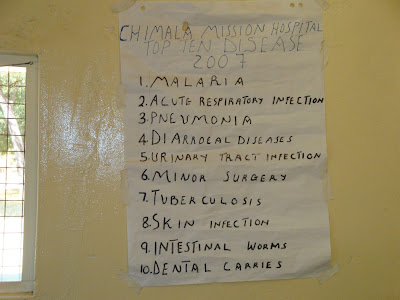The next day we had some time before our scheduled information meeting at 4:00, so Bill took us on a walking tour of the mission. It is amazing! It is much larger than we had imagined, and there is so much work going on!
First, just a little history about Chimala-----
In 1948 Eldred Echols went to Dar es Salam, Tanzania, to ask for permission to enter the country to preach. He was not granted permission to preach. He also found out that the native Tanzanians were not permitted to sell land to foreigners. However, two farms were located that had been owned by Germans since before World War I. American churches gathered money to buy the farms so that Americans could enter Tanzania. One farm was continued to be used as a farm. The other farm, which had been a pig farm, was located on a mountain. A preaching school was established there. When Tanzania got it's independence from Great Britain in 1961, the government said that the Americans had to leave unless they established some kind of benevolent or social service work. It was decided that a hospital was really needed. The mountain farm land was determined to be too remote for the hospital, so a better place was found. A rural hotel sitting on 490 acres was purchased. That was the beginning of the Chimala Mission and Hospital.
The hospital got its start in a small metal building from which medicine was dispensed. The next two photos show that small building.

Eddie, Debbie, Ron, and Jan

The current hospital has more than 140 beds and serves a population of about 100,000 in the Chimala area. The next largest hospital is 50 miles away. The main part of the building is a square shape with a large central courtyard.
The next photo shows the side of the hospital that faces the highway through Chimala; the highway is a main road in the country. There are markets, bus stops and truck scales directly across the highway from the hospital.

Families wait to visit and care for their loved ones who are hospitalized.

This is one of the waiting areas. The benches are concrete.
The next photos are of the baby ward. There are no private rooms! There are only two doctors for the entire hospital. There are nurses, but their main job is dispensing medicines. Family members must stay with patients, cook for them, feed them, and wash their clothes. Notice the mosquito nets above the beds. These photos were taken during the daytime, when the nets are not in use.



The next pictures were taken in the children's ward. Several of these children had malaria. There were a couple with broken legs. There is no orthopedic surgery, so traction was in use for broken legs. We saw one boy with both legs suspended above his bed.

The next photo shows some nursing students from Harding University. They, along with their teacher, spent a month helping at the hospital. They must have learned a lot about medical care in a third world country! They were especially excited about getting to help deliver babies. A couple of the girls got to help deliver babies on their own birthdays!

Next is an adult ward.

Next are views of the courtyard area with a pavilion in the center. The pavilion is used for devotionals held each morning at 7:30. The mountains in the background are where the original mission site was located.







3 comments:
Wow. The hospital pictures are fascinatingly sad. I hope I get to participate in a medical mission someday. (Although hopefully I won't have to wear those horrible 1960's scrub dresses that the nursing students were wearing!)
I am glad that you all did not need to have surgery there. However, it is good that there is some form of medical care.
It's hard to believe that there are only TWO dr's for that many beds! What a blessing this mission is to the community!
Post a Comment